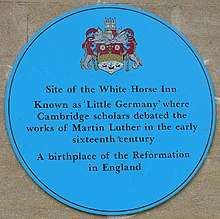White Horse Tavern, Cambridge

The 'White Horse Tavern' or 'White Horse Inn'[1] was allegedly the meeting place in Cambridge for English Protestant reformers to discuss Lutheran ideas, from 1521 onwards.[2] According to the historian Geoffrey Elton the group of university dons who met there were nicknamed 'Little Germany'[3] in reference to their discussions of Luther. Whilst the pub undoubtedly existed, several scholars have questioned the existence of the 'White Horse' meetings - they are described by John Foxe in his Book of Martyrs, but no other evidence for them exists.[4] [5][6][7] Gergely M Juhász writes that 'Foxe’s romantic image of these students and scholars convening secretly on a regular basis in the White Horse Inn… is unsubstantiated', and Alec Ryrie refers to it as 'the stubborn legend of the White Horse Inn.'[6][4]
Attendance
According to Foxe, among those who attended these meetings were the future Archbishop of Canterbury, Thomas Cranmer, the future Bishop of Worcester, Hugh Latimer and the reformers Robert Barnes, Thomas Bilney, Miles Coverdale, Matthew Parker, William Tyndale, Nicholas Shaxton, John Rogers and John Bale. The group also included future conservatives like Stephen Gardiner, the future Bishop of Winchester.[8] However, according to Tyndale's biographer David Daniell, not all of these men were in Cambridge at the same time, and there is no evidence that Tyndale met any of them until after he had left Cambridge.[5] He writes that 'The hard evidence that any of them, in Cambridge, were ever in the same place at the same time, never mind together in the snug of a Tudor pub, is minimal.’[5]
Cranmer's Attendance
According to MacCulloch,
It was natural that his [Cranmer's] Protestant admirers should later give him respectable evangelical credentials for the 1520s, and that they should provide him with retrospective honorary membership of the famous White Horse Tavern...However we need to treat such well-meaning efforts with scepticism. Thirty years ago Professor C. C. Butterworth pointed out that all subsequent talk of the White Horse circle has been built up from a single reference in Foxe's Book of Martyrs; moreover, Foxe is quite specific about which colleges provided regulars for the group, and Jesus [Cranmer's college] is not among them (neither, for that matter, is Gardiner's Trinity Hall).[9]
Further, Gascoigne observes, "He [Cranmer] seems to have played no part in the White Horse circle...,"[10] but McGrath cautions, "Although it is thought that accounts of the activities and influence of this group may have been somewhat embellished, there is no doubt that Cambridge was an important early centre for discussion of Luther's doctrine of justification by faith."[11]
Location
The tavern was located on the site of King's Lane, to the west of King's Parade.[8] When the King's College screen was extended in 1870, the tavern was demolished, but a Blue Plaque on the college's Chetwynd Court commemorates this.[12]
Further reading
https://www.whitehorseinn.org/2016/01/why-we-call-our-radio-program-white-horse-inn/
See also
References
- ↑ L. F. Salzman ed. "Friaries: Austin friars, Cambridge" in A History of the County of Cambridge and the Isle of Ely Vol.2 (London: 1948), 187-290
- ↑ J. D. Mackie, The Earlier Tudors, 1485-1558 (OUP, 1991), p. 343.
- ↑ Geoffrey Rudolph Elton, England under the Tudors: Third Edition (Routledge, 2005), p. 111.
- 1 2 Alec., Ryrie, (2003). The Gospel and Henry VIII : evangelicals in the early English Reformation. Cambridge, UK: Cambridge University Press. ISBN 0521823439. OCLC 57300265.
- 1 2 3 David., Daniell, (2001) [1994]. William Tyndale : a biography. New Haven, CT: Yale University Press. ISBN 0300068808. OCLC 794004235.
- 1 2 1971-, Juhász, Gergely, (2013). Translating Resurrection : the debate between William Tyndale and George Joye in its historical and theological context. Boston: Brill. ISBN 9004248943. OCLC 888242509.
- ↑ Foxe, John (1589). Actes and monuments (AKA Book of Martyrs). London.
- 1 2 Elisabeth Leedham-Green (1996). A Concise History of the University of Cambridge. Cambridge University Press. p. 44.
- ↑ D. MacCulloch, Thomas Cranmer: A Life (Yale: YUP, 1996), 25.
- ↑ B. Gascoigne, A Brief History of Christianity Rev. Ed. (London: Robinson, 2003), 119
- ↑ A. McGrath, Christianity's Dangerous Idea: The Protestant Revolution, a History from the Sixteenth Century to the Twenty-First (London: SPCK, 2007) 108.
- ↑ King’s Parade / Senate House Hill Archived 2011-09-27 at the Wayback Machine.